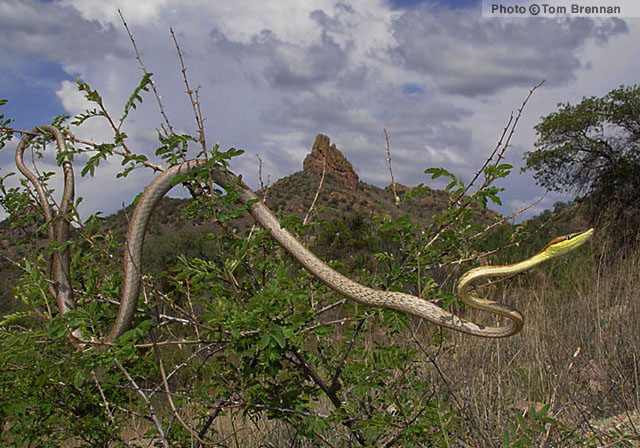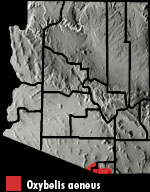Online Field Guide to The Reptiles and Amphibians of Arizona



Santa Cruz County, AZ
 Santa Cruz Co., AZ |
| BROWN VINESNAKE Oxybelis aeneus |
Mildly-Venomous
|
| DESCRIPTION: A long (up to 1,620 mm or 60″ in total length) and exceptionally thin snake that closely resembles a vine. Coloration ranges from gray to silver-gray or copper with short, dark, dash-like lines at mid-body. The head is very narrow, pointed, and elongated. A dark line runs from the snout, through the eye, and onto the neck. A furrow runs from the eye to the snout on each side of the head. The throat and lower sides of the face are often bright yellow to yellow-green. This yellow coloration extends onto the underside of the neck and then grades into a plain, cream colored belly. The pupils are round and the scales are smooth.
DISTRIBUTION: This snake has an enormous range extending from South America through Mexico and into extreme south-central Arizona. In our state it has only been documented from the Atascosa, Patagonia, and Pajarito mountains at elevations ranging from 3,600′ to 6,200′. HABITAT: Within Arizona this snake inhabits the Madrean Evergreen Woodland community and the upper reaches of adjoining Semidesert Grassland. It is usually found in trees or low shrubs on relatively open, steep, and grassy slopes but is also encountered along canyon bottoms with dense vegetation. DIET: Its diet consists or lizards, frogs, fish, and insects. REPRODUCTION: A clutch of up to eight eggs is laid in summer. Hatchlings begin to appear in August. Bartlett. 2000. Snakes of North America: Western Brennan, T. C., and A. T. Holycross. 2006. A Field Guide to Amphibians and Reptiles in Arizona. Arizona Game and Fish Department. Phoenix, AZ Fowlie. 1965. The Snakes of Arizona. Azul Quinta Press, Fallbrook, California Lowe, Schwalbe, Johnson. 1986. The Venomous Reptiles of Arizona. Nongame Branch Stebbins. 1985. Western Reptiles and Amphibians. Houghton Mifflin. New York, NY |
|
Visit Partners in Amphibian and Reptile Conservation:


HOME
Copyright © 2023, Arizona Game and Fish Department. All rights reserved.
If you make use of the textual contents of this site in reports, publications, etc. please cite and credit the author(s) and photographer(s). All photos on this website are copyrighted. However, those found in the species account section may be used for any noncommercial scientific, educational, or conservation purposes provided that photographs are not altered and continue to bear the copyright symbol and name of the photographer. Please contact the photographer regarding commercial use of copyrighted photographs.











